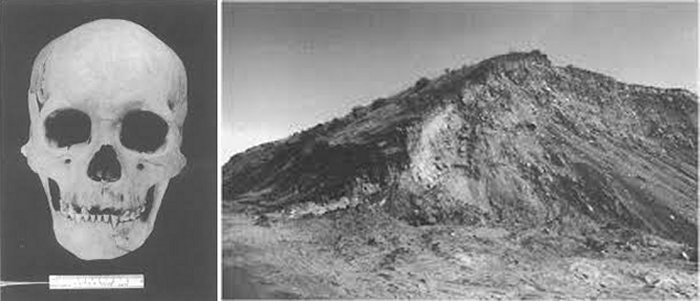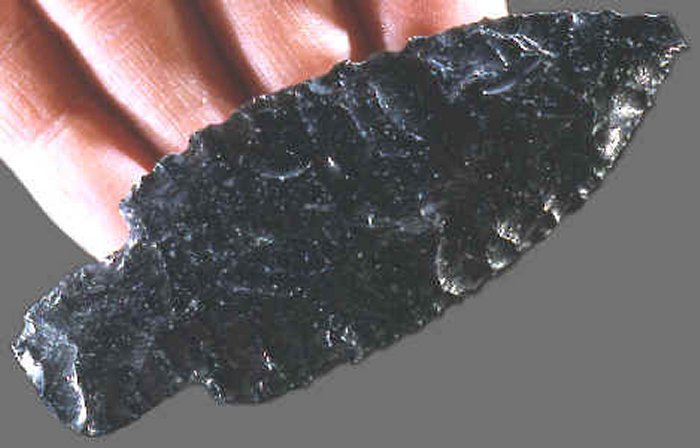Ellen Lloyd – AncientPages.com – In January 1989, a worker discovered the remains of an ancient skeleton in a quarry near Buhl, Idaho, United States.
The skeleton was named the Buhl Woman, sometimes referred to as “Buhla, and it’s truly unique. The 11,000-year-old skeleton is one of the oldest skeletons ever discovered in North America.

Left: Skull of Buhl Woman Right: Burial where the Buhl Woamn was discovered. – source
Only a handful of skeletons of this age had previously been unearthed in North America.
Before the Buhl Woman was reburied in 1991, scientists from the Arkansas Archeological Survey examined the body. The Buhl Woman died young, when she was only between 17 and 21 years old.
Radiocarbon dating of the bones revealed she died at 10,675 ± 95 B.P. (before the present).
Analysis of different carbon and nitrogen isotope ratios in Buhl Woman’s bone collagen suggests that she mainly ate meat and some fish. At the same time, wear patterns on her teeth indicate that the food was cooked before being eaten.

Artifact discovered in the Buhl Woman burial. Image credit: Peter A. Bostrom – source
This finding meshes with recent discoveries in Peru, suggesting that the Paleoindian diet was much more complex and varied than the longstanding “big game hunter” hypothesis would allow. At two 11,000-year-old sites, archaeologists have found evidence of the butchering, cooking, and eating of birds, fish, and shellfish.
Further examinations showed her skull was similar to American Indian and East Asian populations. It contrasts with the morphology of several other early skulls, including Kennewick Man, described as Caucasoid.
According to anthropologist Richard Jantz of the University of Tennessee, the Buhl Woman did not fit into any modern group but was most similar to today’s Polynesians. Twenty-five teeth were recovered from the Buhl burial.

Artifacts discovered in the Buhl burial appear to be offerings. Image credit: Peter A. Bostrom – – source
What caused her death remains unknown, but she appeared generally healthy then. However, her tooth enamel and bone development indicated periodic malnutrition and stress. It is possible the nutritional stress was due to seasonal and/or the result of childhood diseases.
Four artifacts and one unidentified incised badger were found with the Buhl skeleton.
The badger bone was most likely a grave offering because no other bones were found at the site. The other artifacts included one pressure-flaked stemmed biface, a portion of a bone needle, and two fragments of an incised bone awl or pin. Scientists suspect the artifacts were burial offerings.
Sketons Older Than The Buhl Woman Have Been Found In America
The Buhl Woman is one of the oldest unearthed skeletons in North America, but archaeologists have also found even older human bones. As previously discussed on Ancient Pages, “an 11,500-year-old skeleton discovered in Alaska raises new questions about who inhabited North America in the distant past.
Examination of the skeleton shows North America was settled by previously unknown people who lived there, creating several settlements and later mysteriously vanishing.
The 12,700-year-old Anzick Child is the oldest genome ever found in the Americas. This is the second-oldest human genome ever found on the continent, and it belongs to a young child, a girl who was just six weeks old when she died.
Scientists say there has never been any ancient Native American DNA like it before and hailed the genetic evidence as a milestone.”
New archaeological discoveries will, without doubt, shed more light on the first inhabitants of North America, but the Buhl Woman is and will long remain a fascinating find.
Written by – Ellen Lloyd – AncientPages.com
Updated on November 30, 2023
Copyright © AncientPages.com All rights reserved. This material may not be published, broadcast, rewritten or redistributed in whole or part without the express written permission of AncientPages.com





